In the last supplement to Decanter Magazine on California wines, Sonoma based wine columnist Dan Berger investigates how California winemakers are adapting to the evolution of American wine lovers: they want less oak, less alcohol, less ridiculously high prices, and more elegance and balance.
“The US consumer wants a lighter, more drinkable wine, one that has the dinner table in mind, and California winemakers are slowly catching on.” explains Dan Berger in his article.
One of his interviews is with Steve Cornwell, operation manager for MacArthur Beverages in Washington DC. “Consumers are developing their own palate, which is quite a bit apart from what the press and magazines are saying. Also, there is the influence of bloggers, and consumers looking for different styles” says Cornwell.
Many wine lovers are definitively backing off from the expensive bigger style of wine, the “Parker wines”, and they find plenty of imported wines that offer balance and good fruit at a modest price.
So how are California wineries adjusting to the evolving American palate?
According to Rod Berglund, winemaker for Joseph Swan Vineyards, his winery has already made the shift: “In the past, when we talked about Pinot Noir with subtlety and elegance, you'd get a blank stare. But now that consumers are exposed to it, they prefer this style of wine, which offers better balance and a highter level of compatibility with food. Those are the styles that we are selling now.” says Berglund.
For David Munksgard, winemaker for Iron Horse Vineyards, his Pinot Noir wines are actually showing better when their alcohol levels are closer to 13.5% then 14.5%.
In a related article in the Los Angeles Times featuring Adam Tolmach of The Ojai Vineyard, the winemaker confesses: “We got the scores we wanted, but we went away from what I personally like. We lost our rudder when we went for ever bolder, riper flavors.”
He believes that the alcohol levels of his wines, at 15% and higher, are too high but with careful vineyard management, he says, it is possible to retain rich flavors without sending alcohols soaring. It's a matter of spending more time in the vineyard and it's about picking at the right time and from cooler climate vineyards. In the end, Tolmach's goal is to find the balance between California ripeness and European elegance.
Technorati tags: wine food & drink
The smell of wine, oh how much more delicate, cheerful, gratifying, celestial and delicious it is than that of oil. François Rabelais (1495-1553)
Tuesday, August 25, 2009
Wednesday, August 19, 2009
Port4olio Tasting in San Francisco part 2: wines from France, Spain, Portugal, and South America
The following wines are part of the portfolios of importers and distributors International Vineyards and Vinos Unico:
From France (International Vineyards):
• 2005 Cahors Les Comtes de Cahors: from Cahors, an appellation in the southwest of France producing robust red wines made primarily from Malbec. A blend of 70% Malbec, 20% Merlot, 10% Tannat. Dark color, spicy nose, firm tannins, still very young.
• 2001 Domaine du Grand Ormeau Lalande de Pomerol: Lalande de Pomerol is located north of Pomerol on the right bank of the Garonne river. Soils are a mix of clay, stones, and sand, which are particularly beneficial conditions for Merlot. Blend of 80% Merlot, 10% Cabernet Franc, 10% Cabernet Sauvignon. Red-brown color, attractive nose of sweet berries, soft on the palate, mature but tasty.
From Uruguay (International Vineyards):
• 2007 Monte de Luz Cabernet Franc Uruguay: a wine produced by Vignobles Lesgourgues, owner of 6 wine estates in Bordeaux, the southwest of France, and Uruguay. The Lesgourgues family founded the Domaine Monte de Luz in 2000, planting 34 hectares of vines including Tannat, Cabernet Sauvignon, Cabernet Franc, and Syrah in the foothills of the Mahoma Mountains in Uruguay. 100% Cabernet Franc, garnet color, clean fruity aromas on the nose, good acidity, mineral finish.
From Spain (Vinos Unico):
• 2008 Ochoa Navarra Blanco: Bodegas Ochoa grows Tempranillo, Merlot, Cabernet Sauvignon, Garnacha, Moscatel, Viura, and Chardonnay in Navarra, at the foothills of the Pyrenees Mountains. Blend of 70% Viura, 30% Chardonnay, floral nose, fizzy and light-bodied on the palate, refreshing.
• 2008 Bodegas del Abad Abad dom Bueno Bierzo Godello: Bierzo is a up-and-coming wine region in Northeast Spain. The wine is 100% Godello, a white grape variety native to Galicia. The wine is unoaked, dry-farmed, organic. Light yellow color, grapefruit, citrus on the nose, crisp and off-dry on the palate.
• 2006 Bodegas del Abad Abad dom Bueno Bierzo Mencia: 100% Mencia, a red variety native of Bierzo. Wine made with 55 year old vines, dry farmed, organic. Dark color, smooth on the palate with notes of oak, tannins grip a bit on the finish.
From Portugal (Vinos Unico):
• 2007 Paulo Laureano Alentejo Reserve Branco: Alentejo is an emerging winemaking region in Central Portugal, bordering Spain on the east and the Algarve on the south. The wine is 100% Antão Vaz, a local white grape. Light color, pear, tropical fruit aromas on the nose, fresh and bright on the palate.
• 2005 Paulo Laureano Alentejo Reserve Tinto: a blend of local red grapes: 40% Alicante Bouschet, 30% Aragones, 30% Trincadeira. Dark color, blackberry on the nose, rich flavors on the palate, balanced finish.
Technorati tags: wine food & drink
From France (International Vineyards):
• 2005 Cahors Les Comtes de Cahors: from Cahors, an appellation in the southwest of France producing robust red wines made primarily from Malbec. A blend of 70% Malbec, 20% Merlot, 10% Tannat. Dark color, spicy nose, firm tannins, still very young.
• 2001 Domaine du Grand Ormeau Lalande de Pomerol: Lalande de Pomerol is located north of Pomerol on the right bank of the Garonne river. Soils are a mix of clay, stones, and sand, which are particularly beneficial conditions for Merlot. Blend of 80% Merlot, 10% Cabernet Franc, 10% Cabernet Sauvignon. Red-brown color, attractive nose of sweet berries, soft on the palate, mature but tasty.
From Uruguay (International Vineyards):
• 2007 Monte de Luz Cabernet Franc Uruguay: a wine produced by Vignobles Lesgourgues, owner of 6 wine estates in Bordeaux, the southwest of France, and Uruguay. The Lesgourgues family founded the Domaine Monte de Luz in 2000, planting 34 hectares of vines including Tannat, Cabernet Sauvignon, Cabernet Franc, and Syrah in the foothills of the Mahoma Mountains in Uruguay. 100% Cabernet Franc, garnet color, clean fruity aromas on the nose, good acidity, mineral finish.
From Spain (Vinos Unico):
• 2008 Ochoa Navarra Blanco: Bodegas Ochoa grows Tempranillo, Merlot, Cabernet Sauvignon, Garnacha, Moscatel, Viura, and Chardonnay in Navarra, at the foothills of the Pyrenees Mountains. Blend of 70% Viura, 30% Chardonnay, floral nose, fizzy and light-bodied on the palate, refreshing.
• 2008 Bodegas del Abad Abad dom Bueno Bierzo Godello: Bierzo is a up-and-coming wine region in Northeast Spain. The wine is 100% Godello, a white grape variety native to Galicia. The wine is unoaked, dry-farmed, organic. Light yellow color, grapefruit, citrus on the nose, crisp and off-dry on the palate.
• 2006 Bodegas del Abad Abad dom Bueno Bierzo Mencia: 100% Mencia, a red variety native of Bierzo. Wine made with 55 year old vines, dry farmed, organic. Dark color, smooth on the palate with notes of oak, tannins grip a bit on the finish.
From Portugal (Vinos Unico):
• 2007 Paulo Laureano Alentejo Reserve Branco: Alentejo is an emerging winemaking region in Central Portugal, bordering Spain on the east and the Algarve on the south. The wine is 100% Antão Vaz, a local white grape. Light color, pear, tropical fruit aromas on the nose, fresh and bright on the palate.
• 2005 Paulo Laureano Alentejo Reserve Tinto: a blend of local red grapes: 40% Alicante Bouschet, 30% Aragones, 30% Trincadeira. Dark color, blackberry on the nose, rich flavors on the palate, balanced finish.
Technorati tags: wine food & drink
Monday, August 17, 2009
Port4olio Tasting in San Francisco part 1: wines from Eastern Europe and Italy
Earlier this summer, I was invited by Frank Dietrich of Blue Danube Wine at the Port4olio Tasting in San Francisco. The tasting took place at the firehouse in Fort Mason where four California based importers and distributors were pouring wines from Eastern Europe, France, Italy, Spain, Portugal, and South America.
Besides wine, there was an abundance of food including two humongous paellas, a whole roasted pig (that I missed unfortunately), and a selection of cheeses from Cheese Works West.

The paellas at the Port4olio Tasting
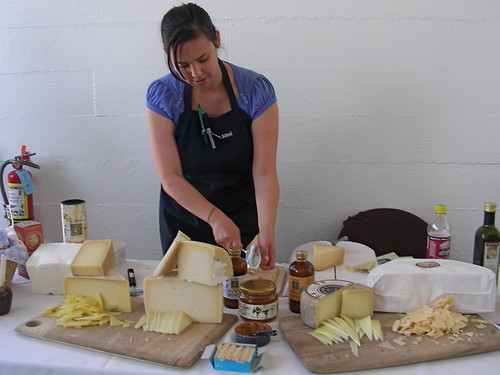
Cheeses from Cheese Works West

Outside the firehouse, you can sip your wine in front of Alcatraz
My notes for the wines I tasted:
From Austria (Blue Danube Wine):
• 2006 Juris Zweigelt Selection: Zweigelt, a cross of Blaufränkisch and Saint Laurent, is the most widely-grown red grape variety in Austria. Dark red color, fruity nose, spicy on the palate, reminded me of a Syrah.
• 2007 Juris Saint Laurent Selection: Saint Laurent is a grape variety related to Pinot Noir. Light red color, light-bodied, a subtle wine.
• 2007 Juris Pinot Noir Selection: floral nose, medium-bodied, spices on the finish.
From Hungary (Blue Danube Wine):
• 2008 Szoeke Matra Irsai Olivér: comes from Hungary's largest historic wine region, which is located at the foot of the Mátra Mountains in the northeast part of the country. Floral nose, strong muscat character, dry.
From Bosnia-Herzegovina (Blue Danube Wine):
• 2007 Citluk Herceg: a unique blend of three native grapes from Herzegovina: Zilavka, Bena and Krkosija. Light, fruity, refreshing.
• 2006 Citluk Kameno: a blend of Zilavka and Bena. Single vineyard, more serious, less fruits and more minerality.
From Croatia (Blue Danube Wine):
• 2006 Bibich Riserva: a blend of three native grapes from Northern Dalmatia, related to Zinfandel: Babich, Lasin, and Plavina. Red berry nose, light to medium bodied, flavorful, tasty.
• 2006 Bibich Mantra Grenache: Grenache from Northern Dalmatia. Sweet nose of ripe fruit, pruny on the palate.
From Italy (Siena Imports):
• 2008 Livon Friulano Collio: Friulano is a native variety from Friuli, previously known as Tocai Friulano. Light color, nose of stone fruits, good acidity.
• 2007 RoncAlto Ribolla Gialla Collio: Ribolla Gialla is a white varietal mostly found in Italy's Friuli-Venezia Giulia region and Slovenia. Fragrant nose, rich aromas of stone fruits and minerals.
• 2000 Costa di Bussia Barolo Tenuta Arnulfo: from Italy's Piedmont region, Barolo is made from 100% Nebbiolo. Red-brown color, sweet fruit on the nose, soft on the palate, mature wine.
• 2001 Di Meo Taurasi Riserva: Taurasi is an appellation from Campania that produces wines made primarily from the Aglianico grape. Deep color, notes of moka, rich and dense on the palate, good acidity.
• 2001 Cesari Amarone della Valpolicella Bosan: a blend of Corvina, Rondinella, and Molinara , this is a single vineyard wine. The grapes are left to dry in special drying chambers for four months before fermentation. After that, aging lasts three years in oak barrels. Dark color, prunes and dried fruits on the nose, velvety palate, very distinctive.
Technorati tags: wine food & drink
Besides wine, there was an abundance of food including two humongous paellas, a whole roasted pig (that I missed unfortunately), and a selection of cheeses from Cheese Works West.

The paellas at the Port4olio Tasting

Cheeses from Cheese Works West

Outside the firehouse, you can sip your wine in front of Alcatraz
My notes for the wines I tasted:
From Austria (Blue Danube Wine):
• 2006 Juris Zweigelt Selection: Zweigelt, a cross of Blaufränkisch and Saint Laurent, is the most widely-grown red grape variety in Austria. Dark red color, fruity nose, spicy on the palate, reminded me of a Syrah.
• 2007 Juris Saint Laurent Selection: Saint Laurent is a grape variety related to Pinot Noir. Light red color, light-bodied, a subtle wine.
• 2007 Juris Pinot Noir Selection: floral nose, medium-bodied, spices on the finish.
From Hungary (Blue Danube Wine):
• 2008 Szoeke Matra Irsai Olivér: comes from Hungary's largest historic wine region, which is located at the foot of the Mátra Mountains in the northeast part of the country. Floral nose, strong muscat character, dry.
From Bosnia-Herzegovina (Blue Danube Wine):
• 2007 Citluk Herceg: a unique blend of three native grapes from Herzegovina: Zilavka, Bena and Krkosija. Light, fruity, refreshing.
• 2006 Citluk Kameno: a blend of Zilavka and Bena. Single vineyard, more serious, less fruits and more minerality.
From Croatia (Blue Danube Wine):
• 2006 Bibich Riserva: a blend of three native grapes from Northern Dalmatia, related to Zinfandel: Babich, Lasin, and Plavina. Red berry nose, light to medium bodied, flavorful, tasty.
• 2006 Bibich Mantra Grenache: Grenache from Northern Dalmatia. Sweet nose of ripe fruit, pruny on the palate.
From Italy (Siena Imports):
• 2008 Livon Friulano Collio: Friulano is a native variety from Friuli, previously known as Tocai Friulano. Light color, nose of stone fruits, good acidity.
• 2007 RoncAlto Ribolla Gialla Collio: Ribolla Gialla is a white varietal mostly found in Italy's Friuli-Venezia Giulia region and Slovenia. Fragrant nose, rich aromas of stone fruits and minerals.
• 2000 Costa di Bussia Barolo Tenuta Arnulfo: from Italy's Piedmont region, Barolo is made from 100% Nebbiolo. Red-brown color, sweet fruit on the nose, soft on the palate, mature wine.
• 2001 Di Meo Taurasi Riserva: Taurasi is an appellation from Campania that produces wines made primarily from the Aglianico grape. Deep color, notes of moka, rich and dense on the palate, good acidity.
• 2001 Cesari Amarone della Valpolicella Bosan: a blend of Corvina, Rondinella, and Molinara , this is a single vineyard wine. The grapes are left to dry in special drying chambers for four months before fermentation. After that, aging lasts three years in oak barrels. Dark color, prunes and dried fruits on the nose, velvety palate, very distinctive.
Technorati tags: wine food & drink
Tuesday, August 11, 2009
A tale of three Rosés
Just before going on vacation, I received three bottles of Rosés from the Kobrand Corporation. We enjoyed them with friends one warm evening with grilled steaks and a nice, big salad.
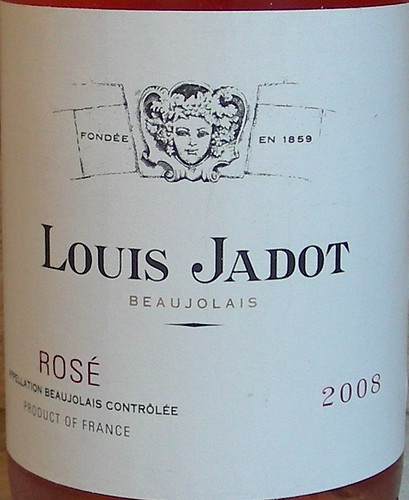 The lightest of the three was the 2008 Beaujolais Rosé Louis Jadot. The Beaujolais region has a long tradition of producing rosé, a wine made from Gamay like the red version. For this Rosé, the Gamay grape is vinified by being immediately pressed like a white wine after limited skin contact. The wine is then put into stainless steel vats. Showing a delicate pink color, it is fresh, dry, citrusy with a crisp finish, and perfectly pleasant as a light aperitif.
The lightest of the three was the 2008 Beaujolais Rosé Louis Jadot. The Beaujolais region has a long tradition of producing rosé, a wine made from Gamay like the red version. For this Rosé, the Gamay grape is vinified by being immediately pressed like a white wine after limited skin contact. The wine is then put into stainless steel vats. Showing a delicate pink color, it is fresh, dry, citrusy with a crisp finish, and perfectly pleasant as a light aperitif.
 The spiciest was the 2008 Wild Rock Vin Gris Rosé. A blend of Merlot, with some Malbec, Syrah and Pinot Noir, the wine comes from Hawke's Bay, a major wine-producing region on the east coast of New Zealand's North Island. Hawke's Bay enjoys a dry and temperate climate with long, hot summers and cool winters. Vin Gris means gray wine and is another term for Rosé. The wine exhibits a medium pink color and aromas of honey and red berry on the nose. It is medium dry on the palate and slighly fizzy with a juicy finish.
The spiciest was the 2008 Wild Rock Vin Gris Rosé. A blend of Merlot, with some Malbec, Syrah and Pinot Noir, the wine comes from Hawke's Bay, a major wine-producing region on the east coast of New Zealand's North Island. Hawke's Bay enjoys a dry and temperate climate with long, hot summers and cool winters. Vin Gris means gray wine and is another term for Rosé. The wine exhibits a medium pink color and aromas of honey and red berry on the nose. It is medium dry on the palate and slighly fizzy with a juicy finish.
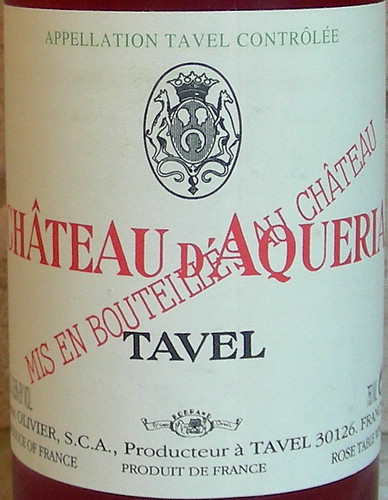 The most serious one (and the one that worked best with the steaks) was the 2008 Tavel Château d'Aquéria. The Tavel appellation is located in the southern Rhône Valley, north of Avignon, and makes only Rosé wines. This one, produced by the Château d'Aquéria, is a blend of Grenache, Syrah, Mouvèdre, Cinsault, Clairette, Bourboulenc, and Picpoul, grown on sandy hillsides and clay. After being completely destemmed, grapes are put into maceration vats for 24 to 48 hours. Grape varieties are then blended two by two for greater aromatic complexity. Then the juice is drawn from the vats and fermentation takes place. All the grape varieties are then blended together and age for several months before being bottled at the estate. The wine has a light red color with aromas of red berries on the nose. On the palate, it is dry, well structured, with fresh mineral notes and a nice complexity on the finish.
The most serious one (and the one that worked best with the steaks) was the 2008 Tavel Château d'Aquéria. The Tavel appellation is located in the southern Rhône Valley, north of Avignon, and makes only Rosé wines. This one, produced by the Château d'Aquéria, is a blend of Grenache, Syrah, Mouvèdre, Cinsault, Clairette, Bourboulenc, and Picpoul, grown on sandy hillsides and clay. After being completely destemmed, grapes are put into maceration vats for 24 to 48 hours. Grape varieties are then blended two by two for greater aromatic complexity. Then the juice is drawn from the vats and fermentation takes place. All the grape varieties are then blended together and age for several months before being bottled at the estate. The wine has a light red color with aromas of red berries on the nose. On the palate, it is dry, well structured, with fresh mineral notes and a nice complexity on the finish.
Technorati tags: wine food & drink
 The lightest of the three was the 2008 Beaujolais Rosé Louis Jadot. The Beaujolais region has a long tradition of producing rosé, a wine made from Gamay like the red version. For this Rosé, the Gamay grape is vinified by being immediately pressed like a white wine after limited skin contact. The wine is then put into stainless steel vats. Showing a delicate pink color, it is fresh, dry, citrusy with a crisp finish, and perfectly pleasant as a light aperitif.
The lightest of the three was the 2008 Beaujolais Rosé Louis Jadot. The Beaujolais region has a long tradition of producing rosé, a wine made from Gamay like the red version. For this Rosé, the Gamay grape is vinified by being immediately pressed like a white wine after limited skin contact. The wine is then put into stainless steel vats. Showing a delicate pink color, it is fresh, dry, citrusy with a crisp finish, and perfectly pleasant as a light aperitif. The spiciest was the 2008 Wild Rock Vin Gris Rosé. A blend of Merlot, with some Malbec, Syrah and Pinot Noir, the wine comes from Hawke's Bay, a major wine-producing region on the east coast of New Zealand's North Island. Hawke's Bay enjoys a dry and temperate climate with long, hot summers and cool winters. Vin Gris means gray wine and is another term for Rosé. The wine exhibits a medium pink color and aromas of honey and red berry on the nose. It is medium dry on the palate and slighly fizzy with a juicy finish.
The spiciest was the 2008 Wild Rock Vin Gris Rosé. A blend of Merlot, with some Malbec, Syrah and Pinot Noir, the wine comes from Hawke's Bay, a major wine-producing region on the east coast of New Zealand's North Island. Hawke's Bay enjoys a dry and temperate climate with long, hot summers and cool winters. Vin Gris means gray wine and is another term for Rosé. The wine exhibits a medium pink color and aromas of honey and red berry on the nose. It is medium dry on the palate and slighly fizzy with a juicy finish.  The most serious one (and the one that worked best with the steaks) was the 2008 Tavel Château d'Aquéria. The Tavel appellation is located in the southern Rhône Valley, north of Avignon, and makes only Rosé wines. This one, produced by the Château d'Aquéria, is a blend of Grenache, Syrah, Mouvèdre, Cinsault, Clairette, Bourboulenc, and Picpoul, grown on sandy hillsides and clay. After being completely destemmed, grapes are put into maceration vats for 24 to 48 hours. Grape varieties are then blended two by two for greater aromatic complexity. Then the juice is drawn from the vats and fermentation takes place. All the grape varieties are then blended together and age for several months before being bottled at the estate. The wine has a light red color with aromas of red berries on the nose. On the palate, it is dry, well structured, with fresh mineral notes and a nice complexity on the finish.
The most serious one (and the one that worked best with the steaks) was the 2008 Tavel Château d'Aquéria. The Tavel appellation is located in the southern Rhône Valley, north of Avignon, and makes only Rosé wines. This one, produced by the Château d'Aquéria, is a blend of Grenache, Syrah, Mouvèdre, Cinsault, Clairette, Bourboulenc, and Picpoul, grown on sandy hillsides and clay. After being completely destemmed, grapes are put into maceration vats for 24 to 48 hours. Grape varieties are then blended two by two for greater aromatic complexity. Then the juice is drawn from the vats and fermentation takes place. All the grape varieties are then blended together and age for several months before being bottled at the estate. The wine has a light red color with aromas of red berries on the nose. On the palate, it is dry, well structured, with fresh mineral notes and a nice complexity on the finish. Technorati tags: wine food & drink
Thursday, August 06, 2009
Tasting Syrah in Crozes-Hermitage
This year, a family reunion took us to the northern Rhône Valley, not far from the village of Mercurol considered to be one of the best locations for the Crozes-Hermitage appellation. Between long family meals and other activities, we took the time to visit two wineries there.

The village of Mercurol
The first one was the Domaine des Entrefaux, a family-owned estate farming 21 hectares of Syrah and 4 hectares of Marsanne and Roussanne on the hills around Mercurol. Grapes are hand-harvested and fully destemmed before being aged in vats or oak barrels.
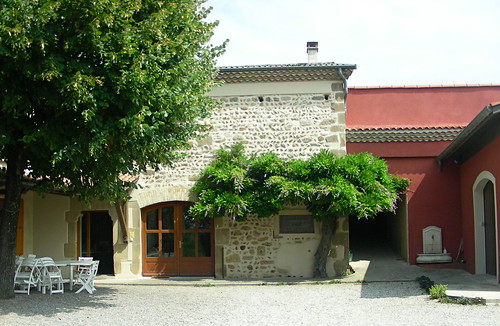
Domaine des Entrefaux
The wines we tasted:
• 2007 Crozes-Hermitage Blanc Domaine des Entrefaux Les Pends: blend of 70% Marsanne, 30% Roussanne from Les Pends, a slopy vineyard in Mercurol. Aromatic nose of stone fruit, oily mouthfeel on the palate, richly balanced.
• 2007 Crozes-Hermitage Domaine des Entrefaux Les Champs Fourné: a blend of estate young vines and from a vineyard called Champs Fourné. Aged in stainless steel vats. Fig and dried fruits aromas on the nose, medium-bodied, bright acidity on the palate.
• 2007 Crozes-Hermitage Domaine des Entrefaux : older vines from the estate. Soil made of rocks, pebble stones and clay. Partly aged in oak barrels. Sweet prunes aromas on the nose. More tannins, spices and licorice on the finish.
• 2006 Crozes-Hermitage Domaine des Entrefaux Les Machonnières: 25 to 50 year old vines from a hilly vineyard in Mercurol. Aged in oak barrels, 5% new. Blackberry jam, plums and prunes on the nose. Toasty, yeasty, tannic on the palate, needs aging.

Wine from the Domaine des Entrefaux
The Domaine des Remizières is not far away on the main road leading to Tain-l'Hermitage. The winery is family-owned since three generations and had originally approximately 4 hectares of vines. Part of the production used to be made at the local cooperative, but since 1973, all the wine is produced at the domain, which has now 30 hectares under vines.
The wines we tasted:
• 2008 Crozes-Hermitage Blanc Domaine des Remizières Cuvée Christophe: blend of 85% Marsanne, 15% Roussanne growing on clayey-limestone hill-side, south-facing soils. Aged in oak barrels. Nose needed to open up. Dry and fat on the palate, complex finish.
• 2007 Crozes-Hermitage Domaine des Remizières Cuvée Particulière: clayey-limestone hill-side soils. Aged in oak barrels, a few new. Pepper and red berry on the nose, full bodied on the palate, good acidity .
• 2007 Crozes-Hermitage Domaine des Remizières Cuvée Christophe: 65 year old vines on average. Aged in oak barrel, 70% new. Spicy, more tannic, needs time.
• 2007 Saint-Joseph Domaine des Remizières: granitic hill-side, south-facing soils. Floral, spicy nose. Round and silky on the palate, tannic finish.
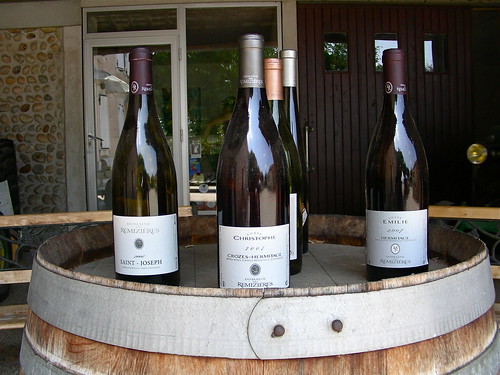
Wine from the Domaine des Remizières
Technorati tags: wine food & drink

The village of Mercurol
The first one was the Domaine des Entrefaux, a family-owned estate farming 21 hectares of Syrah and 4 hectares of Marsanne and Roussanne on the hills around Mercurol. Grapes are hand-harvested and fully destemmed before being aged in vats or oak barrels.

Domaine des Entrefaux
The wines we tasted:
• 2007 Crozes-Hermitage Blanc Domaine des Entrefaux Les Pends: blend of 70% Marsanne, 30% Roussanne from Les Pends, a slopy vineyard in Mercurol. Aromatic nose of stone fruit, oily mouthfeel on the palate, richly balanced.
• 2007 Crozes-Hermitage Domaine des Entrefaux Les Champs Fourné: a blend of estate young vines and from a vineyard called Champs Fourné. Aged in stainless steel vats. Fig and dried fruits aromas on the nose, medium-bodied, bright acidity on the palate.
• 2007 Crozes-Hermitage Domaine des Entrefaux : older vines from the estate. Soil made of rocks, pebble stones and clay. Partly aged in oak barrels. Sweet prunes aromas on the nose. More tannins, spices and licorice on the finish.
• 2006 Crozes-Hermitage Domaine des Entrefaux Les Machonnières: 25 to 50 year old vines from a hilly vineyard in Mercurol. Aged in oak barrels, 5% new. Blackberry jam, plums and prunes on the nose. Toasty, yeasty, tannic on the palate, needs aging.

Wine from the Domaine des Entrefaux
The Domaine des Remizières is not far away on the main road leading to Tain-l'Hermitage. The winery is family-owned since three generations and had originally approximately 4 hectares of vines. Part of the production used to be made at the local cooperative, but since 1973, all the wine is produced at the domain, which has now 30 hectares under vines.
The wines we tasted:
• 2008 Crozes-Hermitage Blanc Domaine des Remizières Cuvée Christophe: blend of 85% Marsanne, 15% Roussanne growing on clayey-limestone hill-side, south-facing soils. Aged in oak barrels. Nose needed to open up. Dry and fat on the palate, complex finish.
• 2007 Crozes-Hermitage Domaine des Remizières Cuvée Particulière: clayey-limestone hill-side soils. Aged in oak barrels, a few new. Pepper and red berry on the nose, full bodied on the palate, good acidity .
• 2007 Crozes-Hermitage Domaine des Remizières Cuvée Christophe: 65 year old vines on average. Aged in oak barrel, 70% new. Spicy, more tannic, needs time.
• 2007 Saint-Joseph Domaine des Remizières: granitic hill-side, south-facing soils. Floral, spicy nose. Round and silky on the palate, tannic finish.

Wine from the Domaine des Remizières
Technorati tags: wine food & drink
Subscribe to:
Posts (Atom)